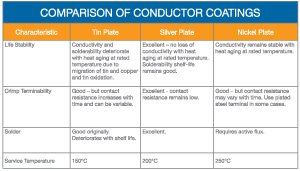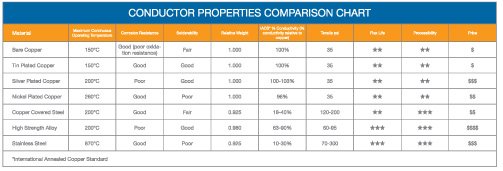Types of Conductors
Many materials are used to transmit electrical energy, but those most frequently specified for types of conductors are copper, copper-covered steel, high strength copper alloys, and aluminum. For more unusual applications, conductors are fabricated from pure nickel, pure silver, copper-covered aluminum, and a host of metals, metal alloys, and metal combinations.
These metals may be coated with rubber, polyethylene, asbestos, thermoplastic, or varnished cambric material, which are called insulators as they have very low electron mobility (few or no free electrons), all of which depend on the voltage of the circuit, the temperature, and whether the circuit is exposed to water or chemicals.
Not all conductive metals have the same level of conductivity – some obviously being better than others – and not all insulators are equally resistant to electron motion. Additionally, it’s also useful to know that some materials experience changes in their electrical properties under different conditions. The following section will go over some of these differences.
Metals Used
Copper
Copper is by far the most widely used conductor material. Among its physical properties are high electrical and thermal conductivity, ductility, malleability and solderability, high melting point, and high resistance to corrosion, wear, and fatigue.
Copper-covered steel
Copper-covered steel combines the conductivity and corrosion resistance of copper with the strength of steel. Three types are presently available, differing primarily in method of producing the composite metal. In one type, molten welding permanently bonds the two components; in another, a copper layer is electroplated over a steel rod; and in the third, the copper and steel are metallurgically bonded.
High Strength Alloys
Though more expensive than copper-covered steel wires, copper alloy conductors are specified because they permit significant size and/or weight reductions especially important in computer and aerospace cable and wire applications. They offer high breaking strength and greater flex life with only a small increase in DC resistance. Cadmium-chromium copper, cadmium copper, chromium copper, and zirconium copper are most frequently used.
Stainless Steel
Stainless steel is used for medical lead wires and cables. Stainless steel has poor conductivity compared to copper and may have to be gold plated to improve the conductivity.
Conductor Coatings
Bare Copper
Bare copper slowly combines with oxygen at room temperatures to form copper oxide. Raising the temperature accelerates this reaction, and at about 180°C and higher, bright copper wire turns black in just a few minutes. Oxide film is a poor conductor of electricity and must be either removed or prevented from forming in order to assure reliability of connections. This is usually accomplished by coating the copper wire with another metal which oxidizes more slowly at operating and processing temperatures. Thus, a coating is sometimes used to facilitate termination (soldering); sometimes as a processing aid (preventing oxidation of the copper at Teflon® TFE extrusion temperatures); and sometimes to offer a lower-resistance connection (“Wire-Wrap” termination). Bare copper is satisfactory at temperatures up to about 100°C.
Tinned Copper
Tinned copper conductors are a soldering aid and are usually specified where this terminating method is to be used. Suitable for conductors continually exposed to temperatures not exceeding 150°C, tinned copper conductors are slightly more expensive than bare copper wires. However, the labor savings gained by using tinned copper more than offset the additional expense, especially when manual twisting and solder dipping of the stripped lead is required.
Silver Coated Copper
Silver plated copper is made by electro-plating pure silver on 18 AWG wire which then is cold drawn to size and finally annealed. Minimum silver thickness is 40 micro-inches. Though higher in cost than tinned copper, silver-coated conductors are recommended for wires operating from above 150°C to about 200°C and in high frequency applications where, because of skin effect, higher conductivity of silver is desirable. They are readily wet by solder, permitting rapid soldering with hand irons. Care must be taken, however, to prevent solder wicking under the insulation, which may reduce conductor flex life. Silver coated copper will oxidize after a few hundred hours at 250°C.
Nickel Coated Copper
Nickel plated conductor (50 micro-inches minimum nickel thickness) is recommended for Teflon® TFE hook-up wire operating for prolonged periods at temperatures of from 200° to 260°C, and where silver coating is objectionable because of possible solder wicking. Ordinary soft solder does not wet nickel as readily as it does tin or silver. It adheres well enough to make a good termination, but will not wick into the stranded conductor beyond the joint, thereby leaving flexibility unimpaired. Connections exposed to temperatures above the melting point of soft solder require special soldering techniques. The term "nickel clad" refers to a much thicker coating – 10% to 30% of the radius of the strand.
Click the charts below to enlarge.
Contact Us
If you have any questions about our cable or wire products, or if you’re looking for a quote, contact us at (800) 905-7161 or through our online form.


